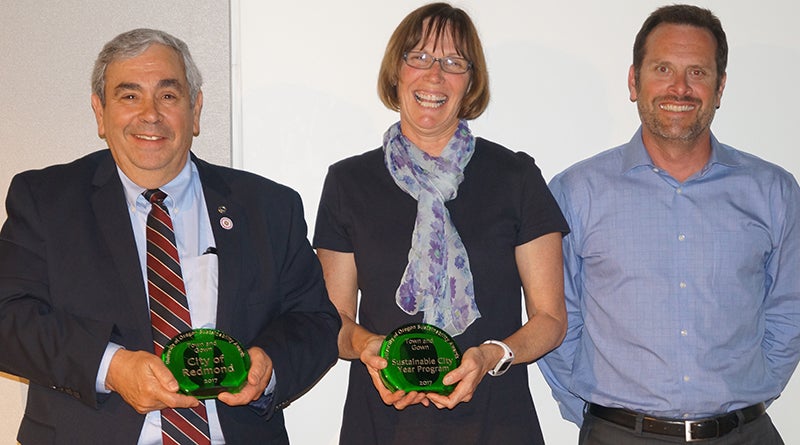The University of Oregon’s Sustainable City Year Program’s (SCYP) Redmond partnership has been recognized with a UO 2017 Sustainability Award in the Town and Gown category. The award is presented to campus individuals or groups for projects that promote, educate, or enhance a more sustainable community.
The projects completed in Redmond by UO students and faculty mentors “invigorated, enhanced, and moved this Central Oregon city closer to its sustainability goals,” the nomination for the program stated. “Community outreach, impact, creativity, and partnership all worked in harmony to achieve these goals.”

Above: From left, City of Redmond Mayor George Endicott, Megan Banks, and Redmond City Manager Keith Witcosky celebrate their 2017 Town and Gown UO Sustainability Award.
The SCYP is part of the Department of Planning, Public Policy and Management (PPPM).
Over the 2015-16 academic year, 22 classes in the SCYP directed their energy into Redmond, with each class working with city staff, elected officials, community stakeholders, and nonprofit partners serving as local and technical resources for students.
“When you get a fresh perspective, you get things you never would have thought of,” Heather Richards, Redmond community development director, said of working with the students.
The SCYP’s innovation stems in part from its multidisciplinary perspective. Students from architecture, business, geography, landscape architecture, nonprofit consultancy, planning, and public administration all visited the city and worked throughout the academic year with community and city contacts.
The interactions brought Redmond stakeholders sharing how local government worked together with students who brought energy and new ideas.
Students also gained experience with a lesser-known but vital aspect of sustainable planning and design: social justice.
“Part of sustainability is the equity component,” noted PPPM Associate Professor Gerardo Sandoval. He framed “the three E’s”—economy, environment and equity—as overlapping circles and “when you work in the middle space, touching all three things, that’s sustainability.”
Dianna Montzka, who graduated in 2016 from UO with a bachelor’s in architecture, noted the many benefits of the SCYP program.
"Working with multiple people from different backgrounds takes clear communication, leadership, and teamwork skills to be successful,” she said. “Being a part of something as simple as bike infrastructure can make a huge difference in how people think about the environment and climate change. As part of the SCYP program, I was able to have impact while still in school."
Cities that partner with the SCYP benefit in multiple ways as well. Redmond is incorporating much of the students’ work into the city’s sustainable future, Richards said. Ideas and recommendations from each project were synthesized into reports ensuring that the students’ work will remain accessible to the community long after the courses ended.
“It’s a leap of faith for the city to take those projects that would have been outsourced and put them into this program,” Richards said, adding that the benefits far outweigh the costs.
The SCYP program continues to be sought out by communities in Oregon and serve as a model for town-gown communities across the country. In 2016-17, the program partnered with the City of Albany and in 2017-18 will partner with TriMet in the Portland metro area.
